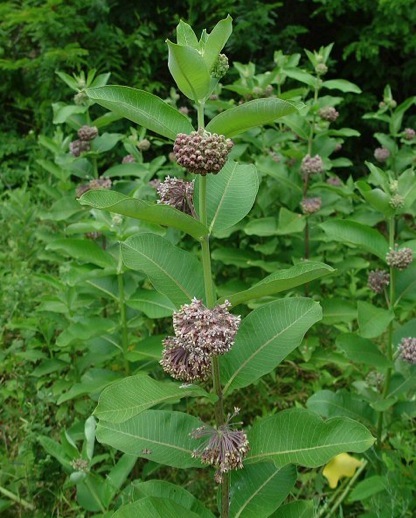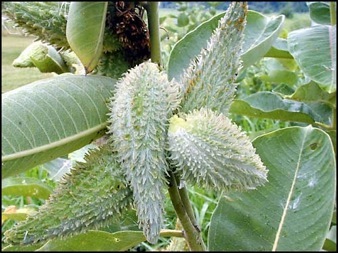Asclepias: Some like it hot, some like it cold
The question is to boil or not to boil.
Actually that’s not quite accurate. There is general agreement that young milkweed shoots, leaves and pods are edible after boiling. The two questions are how many times should you change the water and should the water always be boiling or can you put them in cold water to start? Worse, at least two authoritative sources disagree on those exact things, and exactly the opposite. A third authority considers them famine food only. It is best to say you will have to experiment. We want to get rid of the bitterness because it is toxic. Said another way, don’t eat any milkweed that is bitter after cooking. Taste it and wait 30 seconds or so. Regardless of how cooked, they give me a significant stomach ache. Others folks they don’t bother.
If you read only medical references they will frighten you with talk of cardiac glycosides and one gets the impression that if you as much as look at a milkweed you will drop dead. The state of North Carolina says milkweed is toxic but only in high amounts. That’s good news. The University of Texas says North Carolina also says all milkweeds (Asclepias) shoots, leaves and pods are edible cooked. To quote them:
“Although milkweeds are poisonous raw, the young shoots, leaves and seed pods are all edible cooked. When placed in cold water, brought to a boil and simmered till tender, milkweeds are said to be delicately flavored and harmless. (Poisonous Plants of N.C. State) The flower buds, nectar-sweet flowers and seeds are also edible.”
That may be so but personally, I doubt it. I would not try any milkweeds with skinny leaves. They tend to have more of the bad stuff and I have not as of yet met an edible skinny-leaf milkweed. Again, do not eat any bitter parts of the milkweed.
When most books talk about edible milkweed they are referring to Asclepias syriaca. (ass-KLEE-pee-us sihr-rye-AK-ah.) It’s the most common particularly up north and was all over the place where I grew up, its rough pods unmistakable. Here in central Florida they are no where to be seen. The one I notice the most often here in the wild is Asclepias humistrata. Actually five were in medicinal use in Florida with no mention of them as food.The pods are small and they taste awful.
As for the A. syriaca the young sprouts, buds and immature pods were eaten by the Iroquois and prairie tribes. The Chippewas stewed the flowers. The cooked buds taste like okra. Flowers were also dried for winter use. It was also used as a fiber and medicinally as an urinary aid, a contraceptive and the sap as a wart remover.
Asclepias was the name of a legendary Greek physician and god. That is the name the Greeks used for the plant. Syriaca means of Syria, which it is not. In fact, A. syriaca is a native of eastern North America but Linnaeus thought it was from the Middle East. Curiously the rules that govern the naming of plants do not allow a name to be changed because a geographical mistake was made. There has to be a botanical reasons to change a name. The name Pinus palustris means swamp pine yet the tree (the Long Leaf Pine) grows only in high dry areas. It has been denied a name change. Remember that the next time you think botany is a rational science.
And while I had hoped to avoid a particular controversy I get emails on the topic of whether the common milkweed is bitter or not and comments that if my milkweed is bitter I must have made a mistake and picked dogbane. I know two things: 1) The milkweed that grew in our pasture in Pownal, Maine, from the 1950s through the 1970’s was Asclepias syriaca and 2) it was bitter, not horribly so, but bitter. Other areas of the nation Asclepias syriaca is not bitter and people write to me telling me milkweed is not bitter. How can we reconcile this? Sam Thayer, author of Forager’s Harvest and Nature’s Garden, has a possible answer: Introgression. Specifically that is the incorporation of genes from one species or subspecies into another related species or subspecies. We would commonly call it cross pollination.
Said another way where the common milkweed is not bitter it tends to be the only species of milkweed around. Where it is bitter it tends to be one of many species around, the others of which are bitter and not eaten. Plants can’t be choosy. If the pollen fits fertilization takes place even if it the suitor is a bitter relative. This also happens locally among certain palms such as the Pindo Palm and Queen Palm sharing traits. So yes there is non-bitter common milkweed, and there is bitter common milkweed, and there is poisonous bitter dogbane. Ya have to be careful.
To help you tell Milkweed and Dogbane apart, the underside of the milkweed leaf and stem are slightly hairy. Dogbane is not. Veins on the top of milkweed leaf are light green and prominent, on dogbane they are not as prominent and are cream-colored. Milkeweed leaves do not squeak when rubbed, dogbane leaves do. Milkweed leaves grow smaller as you go up the stalk, dogbane leaves grow slightly larger. The milkweed stalk is hollow, the dogbane is solid.
Green Deane’s “Itemized” Plant Profile
IDENTIFICATION: A. syriaca, the most common northern milkweed, is an erect perennial. Three to six feet tall, milky juice, mostly single, stout, hairy stems. Flowers are pink to pink, 5 parted, densely-flowered drooping umbrels. A. syriaca has rough fat pods and leaves with short stalks. Make sure you have the right species. It can mean the difference between a pleasant meal or a bitter pile on your plate.
TIME OF YEAR: Early to mid-summer
ENVIRONMENT: Upland prairies, fields, meadows, waste places, prefers full sun
METHOD OF PREPARATION: Young shoots, leaves and pods boiled in several changes of water. That can vary greatly, some are not bitter some are. Bitter ones should be boiled in copious amounts of water at least once. Whether cold water to start or boiling water to start will have to be learned by experimenting. If the cooked vegetable is bitter, try a different method. Gather leaves in early spring when they first open. Gather seed pods in summer. Parboil for three minutes, then discard bitter water and replace with clean boiling water. (Cold water tends to fix bitterness, other times hot water does.) Repeat this process three times, then cook the leaves for 15 minutes before seasoning them. A pinch of soda can be added during cooking to break down the fiber and improve flavor. The young shoots under six inches long, found during the spring are used as a vegetable. Remove the fuzz on the shoot by rubbing it off. Preparation is the same as for the leaves. Collect flower buds and flowers during the summer. Dip buds in boiling water for one minute, batter and deep fry. When cooked like broccoli, buds are similar to okra. The flower clusters may also be battered and fried. After cooking, buds, flowers and leaves can be frozen. Use like okra in soups. A bit of baking soda in the water will help break down the tough fibers in the seed pod. Parboiled for several minutes, the young pods may be slit, rolled in a cornmeal/flour mixture and fried or frozen for future use.



